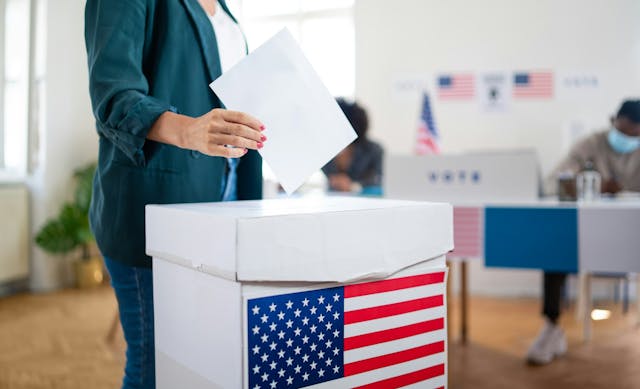Experts Suggest Community Colleges Are Key to Keeping America Competitive

The term "skills gap" is a common one in discussions about America's economic forecast. The notion is that job opportunities for skilled laborers exist, but that not enough laborers have the correct skills to fill the positions.
Oftentimes, talk of a skills gap crops up in reference to vocational jobs -- those requiring "middle skills," which can range from manufacturing jobs to some health care positions.
"The demand for vocational and skilled trade jobs is stronger than it has been in some time, though it's hard to make generalized comments about all of the U.S. economy," said Joshua Wright, director of marketing and public relations for Economic Modeling Specialists International. "Every metro has a distinct mix of industries that drive demand for workers; in Detroit, a manufacturing-based economy, the need for machinists is likely greater than in Provo-Orem, Utah, which is centered on the tech sector."
Much of the training for such jobs has fallen on the shoulders of community colleges around the nation. Though some employers offer on-the-job training and apprenticeships, changes in industry have shifted the way students and workers learn."Health care has really broadened that definition , where training happens a lot in the classroom," said Lauren Eyster, senior research associate at the Income and Benefits Policy Center at the Urban Institute. "There's still the work-based learning component to it, because if you're training to be a nurse or an aide, you have to have time at a hospital or nursing facility."
Jobs such as dental hygienist are often used as examples of middle-skill positions that provide a middle-class wage. Dental hygienists can go to work with an associate's degree and make around $70,000 per year, according to the Bureau of Labor Statistics.
But in order for everyone to benefit from the demand for skilled labor, employers and educational institutions -- such as community colleges -- must cooperate closely, said Charles A. Goldman, senior economist at the RAND Corporation.
"It's crucially important for educational institutions and other training providers to be tightly coordinated with industry and employers," Goldman said.
"Employers get very frustrated if training programs aren't producing graduates who are suited to the jobs they have. It's a more crucial issue at the certificate or associate's degree level compared to the bachelor's degree -- if you think about the bachelor's degree, there's a certain expectation in society that part of getting a bachelor's degree is a broad educational curriculum. When you're only talking about a one-year certificate program or two-year associate's, the emphasis is far more on practical skills." - Charles A. Goldman, RAND Corporation
Community colleges train almost half of undergraduates in the U.S., according to a 2014 report from Economic Modeling Specialists International. For those who obtain occupational two-year degrees, the unemployment rate is 4 percent -- contrasted with a 4.8 percent unemployment rate for those with academic two-year degrees.
But even with employer cooperation, community colleges face challenges in providing training programs for skilled labor.
or occupational training, ideally, you want to hire somebody with potentially some experience in the field -- a master in that profession," Eyster said. "Often, they can make more money if they stay in the industry. For example, nurses -- they have their RN or bachelor's or master's, they're likely to be able to make more money being a nurse rather than teaching people to be a nurse, because community colleges cannot pay as much. That's a real challenge.""For vocational
Vocational jobs also have to deal with changing expectations, Eyster said. For a job such as welding, which requires long hours and hard physical labor, employees need to be offered salary and benefits to make it attractive -- and need to see a clear pathway to advance in their careers.
Employers may also suffer if workers have misconceptions about what opportunities are available in middle-skill jobs.
and skilled trade areas," Wright said. "True, the downturn in manufacturing was severe from late 2007 to late 2009 early 2010, but retiring workers, the reshoring of some firms, and other factors have led to more job openings in manufacturing than most think.""The biggest misconception, from our vantage point, is that there are not good job opportunities in vocational
That's true not just for manufacturing, but for construction, finance and insurance, IT, and food services, Wright said.
With opportunity comes danger, however. Students should beware of institutions that are just out to make money, said Kevin G. Welner, director of the National Education Policy Center at the University of Colorado-Boulder."The overwhelming majority of states have decreased their commitment to public higher education," Welner said. "Meanwhile, for-profit colleges have arisen, often selling job training and taking advantage of federal student loan guarantees while providing education of inconsistent quality."
Such for-profit colleges highlight the importance of community college systems across the nation, Welner added.
"Community colleges can be very valuable for our society, but they’ll waste away without public support," he said.
As the U.S. continues to compete in a global market, skilled laborers will play a key roll -- and providing training for such workers should trump politics or partisan affiliation, Goldman pointed out.
"This is a topic that should have appeal to people across the political spectrum," he said. "Everyone wants the U.S. economy to be robust and competitive, I presume all Americans think we should provide opportunities for people to better themselves."Photo Credit: Markgraf / shutterstock.com



